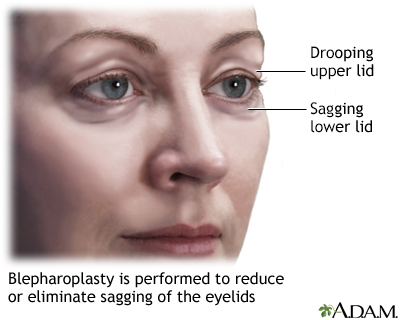UF Health Wellness University Hosting Day of Free Seminars
UF Health Wellness University is kicking off December with four free seminars on Thursday at the Hilton University of Florida Conference Center. Those…

Update your location to show providers, locations, and services closest to you.
Eyelid lift surgery is done to repair sagging or drooping upper eyelids (ptosis) and remove excess skin from the eyelids. The surgery is called ptosis repair and blepharoplasty.
Sagging or drooping eyelids occur with increasing age. Some people are born with droopy eyelids or develop a disease that causes eyelid drooping.
Blepharoplasty; Ptosis repair - eyelid lift
Eyelid surgery is done in a surgeon's office. Or, it is done as outpatient surgery in a surgery center.
The procedure is done as follows:
An eyelid lift is needed when eyelid drooping reduces your vision. You may be asked to have your eye doctor test your vision before you have the surgery.
Some people have an eyelid lift to improve their appearance. This is cosmetic surgery. The eyelid lift may be done alone or with other surgery such as a browlift or facelift.
Eyelid surgery will not remove wrinkles around the eyes, lift sagging eyebrows, or get rid of dark circles under the eyes.
Risks for anesthesia and surgery in general include:
Risks for an eyelid lift may include:
Medical conditions that make blepharoplasty more risky are:
You can usually go home the day of surgery. Arrange ahead of time for an adult to drive you home.
Before you leave, the health care provider will cover your eyes and eyelids with ointment and a bandage. Your eyelids may feel tight and sore as the numbing medicine wears off. The discomfort is easily controlled often with over-the-counter pain medicine.
Keep your head raised as much as possible for several days. Place cold packs over the area to reduce swelling and bruising. Wrap the cold pack in a towel before applying. This helps prevent cold injury to the eyes and skin.
Your doctor may recommend an antibiotic or lubricating eye drops to reduce burning or itching.
You should be able to see well after 2 to 3 days. Do not wear contact lenses for at least 2 weeks. Keep activities to a minimum for 3 to 5 days, and avoid strenuous activities that raise the blood pressure for about 3 weeks. This includes lifting, bending, and rigorous sports.
Your doctor will remove the stitches 5 to 7 days after surgery. You will have some bruising, which may last 2 to 4 weeks. You may notice increased tears, more sensitivity to light and wind, and blurring or double vision for the first few weeks.
Scars may remain slightly pink for 6 months or more after surgery. They will fade to a thin, nearly invisible white line and are hidden within the natural eyelid fold. The more alert and youthful look usually lasts for years. These results are permanent for some people.

Few J, Ellis M. Blepharoplasty. In: Rubin JP, Neligan PC, eds. Plastic Surgery, Volume 2: Aesthetic Surgery. 4th ed. Philadelphia, PA: Elsevier; 2018:chap 9.
Salmon JF. Eyelids. In: Bowling B, ed. Kanski's Clinical Ophthalmology. 9th ed. Philadelphia, PA: Elsevier; 2020:chap 2.



UF Health Wellness University is kicking off December with four free seminars on Thursday at the Hilton University of Florida Conference Center. Those…
